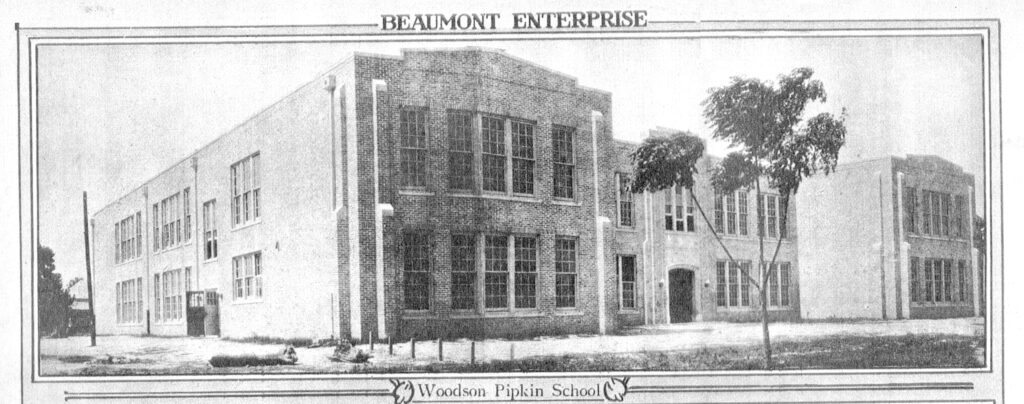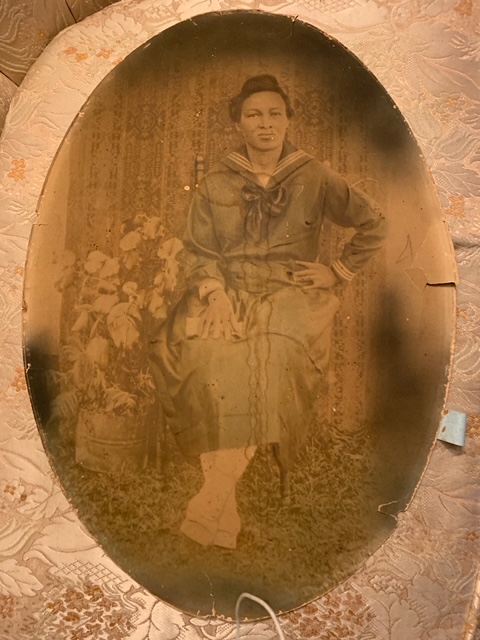Last year, on the second Annual Historic Magnolia Cemetery Tour, we added the history of Pipkin School and what we know of Martha Mack Cemetery, which is located on the south end of Magnolia, near the mausoleum. From now on, both will be permanent fixtures of our annual tour because much of their history needs to be told. It’s part of the cemetery. Magnolia’s new addition is on the grounds where the brick building of the Pipkin School once stood.
Here is its history.
For much of the twentieth century, many African American Beaumonters began their education at Pipkin Elementary School on Pine Street. In 1911, when Millard Elementary School for Whites received a new brick structure, its old two-story wooden building was moved to the Pipkin School location on Pine Street. This building was replaced with a brick structure in the 1920s. In 1974, the City of Beaumont acquired the school and the land, eventually demolishing the building in 1981. The property was sold to Magnolia Cemetery in 1999.
Pipkin School was named after Woodson Pipkin, who, along with Charles Pole Charlton, founded the first locally operated Black school in Beaumont. Pipkin was a formerly enslaved person who had received an education and realized the importance of literacy for emancipated African Americans. A Methodist minister, he co-founded an African Methodist Episcopal church, which also served as an education center. Pipkin also made his living as a teamster, clearing roads and hauling goods with his horse and mule teams. He lived in a two-story home on Main Street, near where the Beaumont Police Station is today. Woodson Pipkin died in 1918 and was buried in Martha Mack Cemetery.
An ongoing mystery is whether Reverend Pipkin was moved to Evergreen Cemetery, along with the rest of the residents of Martha Mack. The history is unclear, and further research is needed. The original site of the Martha Mack Cemetery either is (if the graves are still there) or was the first Black cemetery in Beaumont. Again, we can’t go forward until we find out if all the graves were moved. There was also another family cemetery north of Martha Mack. It was called the Happ graveyard. Happ is the name of the family that used to own the property in the past. The Happ site was a cemetery, not a graveyard, because graveyards are only on church grounds. (I don’t make the rules.) There was a church on the corner of Pine and Bayou called Maple Grove Baptist Church, but this was way after the Happs owned this land.
The history of Martha Mack the person is also a work in progress. I will say that there are many researchers on her trail. I will explain this as it kind of looks complicated, but if you’re a spiritualist, you may think that there is guidance in a group of people unknowingly researching the same subject.
In the beginning, I heard there was a Black cemetery adjacent to Magnolia named Martha Mack Cemetery. I wanted to learn more about it and who Martha was, but little was known about her except that she worked for the McFaddins as a laundress. Then, documents and census records were found, but these added more questions rather than providing answers. Meanwhile, unknown to me and a few others who had also begun looking into her history, a couple of descendants were also researching Martha. It all came to a climax a few weeks before the cemetery tour when many more court records were found and we started seeing the paper trail of the land as well as Martha’s history. The information we now have is in the hands of her descendants. Following their research, the story of her life will be told through their words. There is much more to uncover, but at least now everyone will benefit because we know each other and can share our findings.
Based on what I know, Martha experienced many hardships during her life, but she was a fighter and took no crap. A few Beaumonters gave her the shaft legally because—I guess—she was romantically involved with a widower, the Englishman H. E. Simpson, and had two daughters, Roxie and Barsheba. We will definitely get into this story when all the facts are in because it needs to be told. It is uncertain who will tell it, but I’m sure Martha will make it clear because sometimes this is how things work.
I once wrote a blog post on the notable women of SETX. Basically, I wrote it because the Houston Chronicle’sarticle on the same topic had too many Playboy centerfolds and musicians. Many local women did great things, and some of those things benefited the area as a whole. There are truly many stories to tell, and I would be happy to tell them in person, but I’ll leave the link at the bottom of this blog. I won’t leave the link to the original Houston Chronicle article because they changed thelist! At the time, my friend Ginny said that I was mad because they didn’t mention Florence Stratton, and she was right. Ginny liked my list and is an advocate of giving women their due. If I ever do another post on this topic, Martha will get the top spot along with her daughters.
I think I need to do an article on what actually went on at this time because I left out John Q. Public. To keep it simple, a person wrote a paper on the Patillo family. He left it at a couple of places, including the Theodore R. Johns Sr. Library. Someone remembered this paper, and this is how a lot of our historical research flourished. The article was excellent, yet the author didn’t add their name. If you read the article, it is by John Q. Public. This is odd, but I will respect the author’s decision. The next odd thing in this story was a researcher who was out and about taking photos of the Patillo house on Avenue F. when someone approached him asking why he was taking pictures. He explained that he was documenting the house with photos for the Jefferson County Historical Commission and then began giving details of the Patillos. It turns out this person was John Q. Public.
There are many twists and turns when you do research, and I’m still trying to figure this one out.
Until next week
Pipkin School / Reverend Woodson Pipkin:
https://www.sfasu.edu/heritagecenter/9619.asp
Notable Women of SETX:





You must be logged in to post a comment.